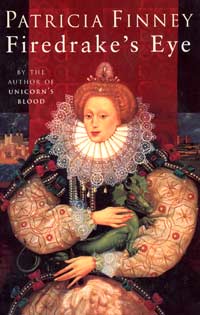FIREDRAKE’S EYE
By Patricia Finney
London, 1583. Loyal courtier Simon Ames has been viciously beaten. Is it a random attack, or is he the victim of a subtly treasonous act? And why has a nonsense poem, written by the lunatic Tom O’Bedlam, suddenly become so popular? Is someone taking the meanderings of a madman too seriously? Who is Tom, and what does his ballad mean? Ames and his dubious friend Becket set out to uncover the truth, but before long they are following a trail of murder, treason and terror.
Historical fiction the way it should be written A talent for writing espionage makes her the le Carre of the 16th century. Her work is as subtle, as complex and as beautifully-crafted as his and she has a poet’s enviable gift as well. Ruth Rendell.

First page sample:
![]() It was I that saw most and have said least in the matter of the firedrake and the nightcrow, the soldier of God and the hunting of that fair white hind, the Queen of England. There has been a plague of silence upon it, made by Sir Francis Walsingham, the Queen’s Moor, darker than the blackest flurry of wings over a dunghill. But Tom of Bedlam is mad and unaccountagle, being a Bedlam beggar, and since I wear his poor scratched hide and stare out of his poor mazed eyes which make my prison windows, so I will tell the tale. And all of it will be the truth.
It was I that saw most and have said least in the matter of the firedrake and the nightcrow, the soldier of God and the hunting of that fair white hind, the Queen of England. There has been a plague of silence upon it, made by Sir Francis Walsingham, the Queen’s Moor, darker than the blackest flurry of wings over a dunghill. But Tom of Bedlam is mad and unaccountagle, being a Bedlam beggar, and since I wear his poor scratched hide and stare out of his poor mazed eyes which make my prison windows, so I will tell the tale. And all of it will be the truth.
![]() First must I ask forgiveness, that this has somewhat of madness colouring it. For my poor skullmate Tom was always at my side, and would often elbow past me and the Courtier to bow to the Queen Moon , and dance and discourse with angels and cower from his devils which were suddenly both his and mine. Let the Queen Moon judge between us.
First must I ask forgiveness, that this has somewhat of madness colouring it. For my poor skullmate Tom was always at my side, and would often elbow past me and the Courtier to bow to the Queen Moon , and dance and discourse with angels and cower from his devils which were suddenly both his and mine. Let the Queen Moon judge between us.
![]() And yet Poor Tom has his uses, for his angels made him windows in men’s heads to see their souls. So I beg you, forgive his yammerings and do not put all of them aside. Perhaps it is only the weight of the infinite that made him rave. So here also is Tom’s madness, woven like gold thread into a good cloth of sense, though who would put gold into a winding cloth unless it were for a prince.
And yet Poor Tom has his uses, for his angels made him windows in men’s heads to see their souls. So I beg you, forgive his yammerings and do not put all of them aside. Perhaps it is only the weight of the infinite that made him rave. So here also is Tom’s madness, woven like gold thread into a good cloth of sense, though who would put gold into a winding cloth unless it were for a prince.
![]() Which it is not, it is a Turkey rug of windings and divergings and turnings and foldings, all in a dance of spiral upon counter-spiral, star upon star, swirl upon movement upon unquietness, all woven by the Queen Moon that sits above us in a silver damask petticoat and smiles. And puts her silver finger with its nail of scarlet upon this knot and that: here was the tale’s genesis, here and there, and there.
Which it is not, it is a Turkey rug of windings and divergings and turnings and foldings, all in a dance of spiral upon counter-spiral, star upon star, swirl upon movement upon unquietness, all woven by the Queen Moon that sits above us in a silver damask petticoat and smiles. And puts her silver finger with its nail of scarlet upon this knot and that: here was the tale’s genesis, here and there, and there.
